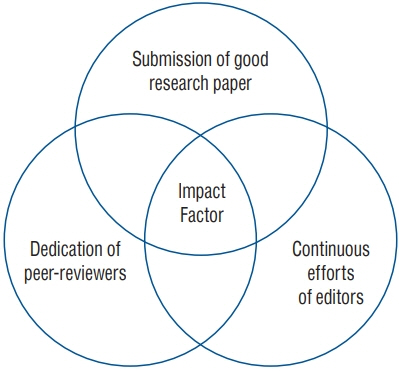J Korean Neurosurg Soc.
2021 May;64(3):321-325. 10.3340/jkns.2021.0094.
The Evolution of Journal of Korean Neurosurgical Society from 2017 to 2020 : The Beginning of a Great Development
- Affiliations
-
- 1Department of Neurosurgery, Soonchunhyang University Bucheon Hospital, Bucheon, Korea
- 2Former Editor-in-Chief, Journal of Korean Neurosurgical Society
- KMID: 2515486
- DOI: http://doi.org/10.3340/jkns.2021.0094
Abstract
- Every researcher wants their research to gain more recognition, and this desire is achieved by publishing their article in a journal with higher impact. It is very important to get researchers interested in the Journal of Korean Neurosurgical Society (JKNS). Therefore, the first goal was to promote the publication of papers in our journal. To do this, a table of contents was sent out, and the citation ranking was announced every 2 months. Several efforts have been made to publish good papers. Foreign speakers, who were invited to a conference hosted by the Korean Neurosurgical Society were contacted and politely requested to write a paper addressing their recent research. Domestic and international researchers highly renowned in their fields were also contacted to submit their novel works to our journal. The journal impact factor of our journal has continued to rise for the last 3 years and reached 1.376 in 2019. It can be said that the JKNS is now competitive with other international neurosurgery journals. These achievements were not due to the efforts of the editorial boards alone. This was because our society members have submitted very good papers, and because many of our members have cited the papers published in our journal. We believe that this will continue in the future. The next step of evolution of the JKNS has begun, and this is the beginning of another great development.
Figure
Reference
-
References
1. Bornmann L, Pudovkin AI. The journal impact factor should not be discarded. J Korean Med Sci. 32:180–182. 2017.
Article2. Chung M, Kim BT. Editorial statistics and best reviewers award 2018 for Journal of Korean Neurosurgical Society. J Korean Neurosurg Soc. 62:1–2. 2019.
Article3. Chung M, Park CK, Yang HJ. Editorial statistics and best reviewer awards 2020 for the Journal of Korean Neurosurgical Society. J Korean Neurosurg Soc. 64:1–3. 2021.
Article4. Clarivate. Journal citation reports. 2019 journal impact factor. Boston: Clarivate Analytics;2020.5. Im SB, Chung M, Kim BT. The influential articles and title words in the Journal of Korean Neurological Society publications between the years 2016 to 2018. J Korean Neurosurg Soc. 63:1–3. 2020.
Article6. Kim BT, Chung M. Evolution of quality improvement for the Journal of Korean Neurosurgical Society. J Korean Neurosurg Soc. 61:425–426. 2018.
Article7. Sinowatz F. The impact of the impact factor. Anat Histol Embryol. 45:159–160. 2016.
Article8. Yang HJ. Journal of Korean Neurosurgical Society from 2001 to 2006, the pivotal period of transition and preparation for making great stride. J Korean Neurosurg Soc. 62:131–135. 2019.
Article
- Full Text Links
- Actions
-
Cited
- CITED
-
- Close
- Share
- Similar articles
-
- Evolution of Quality Improvement for the Journal of Korean Neurosurgical Society
- Journal of Korean Neurosurgical Society for 30 Years
- The Evolution of Caregiving and Attachment
- Junctional Neural Tube Defect
- Editorial Statistics and Best Reviewer Awards 2020 for the Journal of Korean Neurosurgical Society





